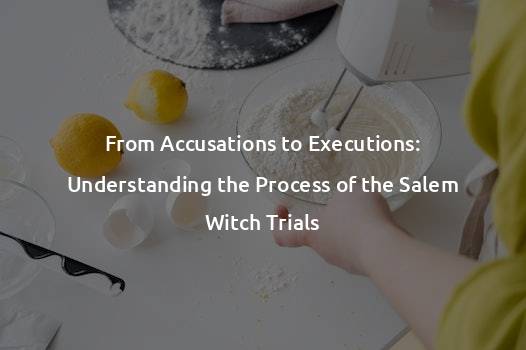From Accusations to Executions: Understanding the Process of the Salem Witch Trials
From Accusations to Executions: Understanding the Process of the Salem Witch Trials
The Salem Witch Trials of 1692 remain one of the most notorious episodes in American history. The events that unfolded in the small colonial town of Salem, Massachusetts, resulted in the wrongful accusations, trials, and executions of numerous individuals on charges of witchcraft. Understanding the process behind these tragic events can shed light on the social, religious, and legal dynamics that led to such a devastating outcome.
The Origins of the Accusations
The Salem Witch Trials were fueled by a combination of religious fervor, societal tensions, and personal conflicts. In the late 17th century, the Puritan community in Salem lived in a strict and close-knit society, deeply rooted in the belief that the Devil was real and actively working to corrupt the faithful. Any deviation from religious norms or suspicious behavior became a potential sign of witchcraft.
The accusations began in January 1692 when a group of young girls, including Betty Parris and Abigail Williams, began exhibiting peculiar behavior, such as fits, contortions, and episodes of hysteria. Unable to explain these phenomena through natural causes, the community attributed them to spiritual influences. The girls claimed that they were being tormented by witches.
Hysteria quickly spread throughout the town, and the girls began pointing fingers at members of the community, accusing them of practicing witchcraft. These individuals were often the marginalized and socially outcast, including elderly women, widows, and those who challenged the established religious and social order. As accusations multiplied, the Salem Witch Trials entered a dark and chaotic phase.
The Process of Accusations and Arrests
Once an accusation was made, the accused were brought before local magistrates, where they faced questioning and intense scrutiny. The trials were conducted in public, allowing townspeople to witness the proceedings, share information, and potentially contribute to the accusations.
The legal process utilized in the Salem Witch Trials was dramatically different from modern judicial systems. The accused had limited legal representation, and traditional rules of evidence were often discarded. Spectral evidence, where the testimony of the afflicted girls about supernatural occurrences was accepted, played a significant role, despite being unreliable and based on subjective interpretations.
Furthermore, “witches” were often subjected to invasive examinations to search for physical marks, known as “witch marks,” believed to be signs of their alliance with the Devil. These examinations, which often involved a humiliating and degrading ordeal, further propagated the idea that the accused were guilty.
The Trials and Executions
The accused witches were eventually arraigned before a grand jury, who decided whether there was sufficient evidence to proceed to trial. Those indicted were then brought to court, where a panel of judges oversaw the proceedings.
The trials themselves were highly chaotic and emotionally charged. Witnesses, primarily the afflicted girls and others accusing the defendants, were often allowed to give hearsay accounts and make assertions without much scrutiny. The presumption of innocence was effectively absent, and guilt was often predetermined.
As the trials progressed, the number of accused increased rapidly. Twenty individuals were executed by hanging, including women, men, and even one man who refused to enter a plea. Several others died in jail due to harsh conditions, leading to a total death toll of at least 25 people.
The End of the Trials
Ultimately, the Salem Witch Trials began to lose credibility when respected figures in the community, such as the minister Increase Mather, publicly criticized the use of spectral evidence. By September 1692, Massachusetts Governor William Phips disbanded the special court established to handle the witch trials and prohibited further arrests.
The aftermath of the trials proved devastating for the community. The once-tight-knit town of Salem became bitterly divided, families torn apart, and trust shattered. Many who had been directly involved in the accusations publicly expressed remorse, acknowledging the flawed nature of the trials.
TLDR;
The Salem Witch Trials were a dark period in American history, marked by wrongful accusations, biased legal proceedings, and tragic executions. The trials were driven by religious extremism, societal tensions, and personal conflicts. Accusations were made based on spectral evidence and subjective interpretations, leading to mass arrests, chaotic trials, and the execution of at least 25 people. Eventually, the trials lost credibility, and Governor Phips disbanded the court. The consequences of the Salem Witch Trials were far-reaching, causing deep divisions within the community and a profound reflection on the flawed process that had taken place.







